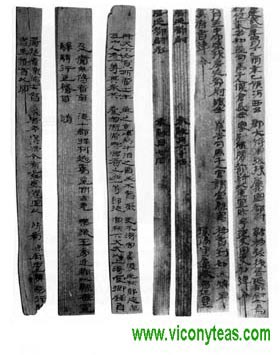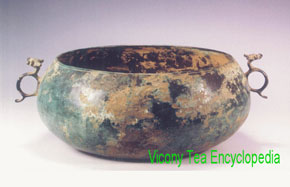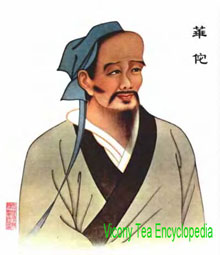Vicony Tea Directory


Chinese Tea Drinking History Before Tang Dynasty (~-618)
 |
|
| Yanzi's Spring and Autumn Annals, the bamboo slips unearthed from the tomb of Han dynasty |
From the Western Zhou Dynasty to the Qin Dynasty: Tea as food and herbal medicine
According to the Records of Huayang Kingdom: the History of Ba written by Chang Qu of the Eastern Jin dynasty, about 1057 BC or so, when Emperor Wu of the Zhou dynasty conquered the Shang dynasty, tea entered and spread in the Central Plains as the tribute from the southwestern area. Since the transportation then was very inconvenient and it was of a long distance between the southwest and the Central Plains, when the tribute of tea arrived in the capital the leaves were no longer fresh, therefore people had to process the tea leaves to be dried tea. Then, what were those dried tea used for? Food, medicine or drink? It was not mentioned in the book. However, according to the records in Yanzi's Spring and Autumn Annals in the Spring and Autumns and Warring States Periods, Yan Ying, the statesman of the State of Qi, often ate "Mingcai"("tea vegetable"). Therefore we could infer that at first tea was used as a kind of food in the southwestern area, and it was also introduced to the Central Plains as food.
In addition, in the Shennong's Classic of Foods, there was the record of "take tea" rather than "drink tea", which indicated that people had already found the curative and refreshing functions of tea in the Qin and Han dynasties, and began to record it. Therefore, we could say that, at least, before the Qin dynasty tea was not used as a kind of drink but greatly promoted and popularized as food and medicine. However, seeing tea as food and medicine is not farfetched because the Chinese medicine always emphasizes the idea of recuperating by taking herbal medicines, among which there is the food therapy of "everything that can be eaten can be used as a medicine".
 |
|
| Bronze utensil used to cook tea in Han dynasty |
Han Dynasty: Tea as herbal medicine and drink
Entering the Han dynasty, the function and status of tea had new breakthrough as well as changes. In the Qin and Han dynasties people put emphasis in the edible and curative function of tea, then its function of thirst quenching as a kind of drink also began to be sought out and emphasized, and it gradually became the indispensable drink of people's daily life. But it was not accidental for people to find out tea's value as a drink; it should be attributed to its curative function. According to the investigations, it was during the process of delving into the detoxification and digestive functions of tea that people began to know its thirst quenching and refreshing functions. And from then on tea entered people's daily life as both herbal medicine and drink, mostly being steamed.
According to the Sima Xiangru's record, tea became one of the herbs in the traditional Chinese medicine at the early Western Han dynasty because of its curative function. According to the records in Discussion on Food written by Hua Tuo in the Eastern Han dynasty and Shen-nong's Herbal Classic by Zeng Guang, the Han people had a deeper understanding that the major curative function of tea was refreshing.
 |
|
| Hua Tuo, a famous chinese physician during the Eastern Han and Three Kingdoms who had had a deep understanding of tea function |
Wei, Jin, Southern and Northern Dynasties: Early stage of Tea Culture
Till the Wei, Jin, Southern and Northern dynasties, the records of tea became very rich, which indicated that tea as a kind of drink had entered people' daily life in a more profound way. In this period, when tea was widely accepted as a pure drink, people gradually connected it with their inner world and began to take on the connotation of culture. The special historic conditions of the Wei, Jin, Southern and Northern dynasties impelled tea to connect with the Chinese traditional schools of Taoism and Confucianism, and tea culture began to bud.
1) The Elixir of the Taoism
In the Wei, Jin and Southern and Northern dynasties, the society was in turbulence and the regimes altered frequently. People felt disappointed to the reality and were deeply influenced by the Taoism, so in the whole society there formed a trend of taking pills to pursue longevity, especially among the men of letters, the royal and noble families.
In the early Wei and Jin dynasties, in pursuit of longevity, people usually took pills of metals and stones, among which a popular one was "Wushishan"(powder of five minerals), a kind of medicine made of 5 minerals. However, according to many historical materials, after taking "Wushishan", people usually would suffer from acute pains and even die. Therefore, people at that time also take herbal medicines. In this process, people gradually figured out that tea had the miraculous effect in preserving and prolonging one's life, thus began to take as the elixir that could promise longevity. People of the Wei and Jin dynasties took a lot of tea, hoping to improve their health, which showed their desire of pursuing longevity. This kind of pursuit was only confined to the physical health at first, and later it developed into the pursuit of the physical and spiritual harmony, approaching the thought of cultivating one's morality- and idea advocated by the Taoism.
2)"advocating Honesty with Tea" of the Confucianism
When tea was connected with the immortal thought of Taoism, it was also attached to the Confucian thoughts and led the thrifty and frugal living style of people then. The ideas of "maintaining one's integrity when poor and contributing to the country when eminent" and "being diligent and thrifty" that were advocated by the Confucianism stroke root in the hearts of the people in Wei, Jin, Southern and Northern dynasties, and merged with tea tasting, which initiated the tradition of "advocating honesty with tea" in tea culture. As opposed to the luxurious practices then, many people showed their lofty aspirations by alluding to tea, demonstrating their frugality. For example, Lu Na used tea to entertain his guests; Qi Emperor Wudi used tea as sacrificial offerings in rituals; and Huan Wen took rice with tea as a meal, etc.
We should first clarify the reasons why tea was seen as a symbol of thrifty life under the social atmosphere then. Firstly it was widely taken by people of both the upper and the lower classes; more importantly, it was very cheap. In another word, the connection between tea and "thrift" was not for its own material property, but its social property, i.e. its price in the market, which played a decisive role. However, we should still attribute the promotion of the connection to the scholars and officials who were deeply influenced by the Confucianism; it was them that connected the social property of tea with the Confucian ideas of "maintaining one's integrity when poor and contributing to the country when eminent" and "being diligent and thrifty", and thus initiated the Confucian tradition of "advocating honesty with tea" in tea culture.
Thus, as a kind of drink, tea was associated with the Chinese traditional thoughts of Taoism and Confucianism which symbolized the budding of tea as a kind of cultural phenomenon in the history.
See Also:

- Chinese Tea
- Chinese Tea Ceremony
- Chinese Top Ten Famous Teas
- Tea Drinking in Chinese Ming Dynasty
- Tea Drinking in Chinese Song Dynasty
- Tea Drinking in Chinese Tang Dynasty
- Chinese Tea Drinking History Before Tang Dynasty
| Green Tea | Black Tea | White Tea | Yellow Tea | Oolong Tea | Dark Tea | Pu Erh | Scented | Flowering | Herbal | Tea Powder |
| Navigation |
| Home (ViconyTeas) |
| Tea Directory (VTD) |
| Tea Importers |
| Tea Exporters |
| Tea Wholesalers |
| Informative Tea Web |
| Tea Association |
| Tea Encyclopedia |
| Online Tea Shop |
| Tea Dictionary Online |
Copyright©2016 | Tea Drinking
